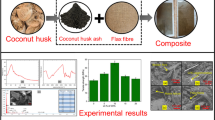Abstract
In this study, a lightweight hierarchical composite was used in various structural applications by combining fox millet husk ash biosilica particles and low-density Amaranthus dubius stem fiber–reinforced in epoxy matrix. Studying the shear strength, wear, and thermal conductivity along with hydrophobic behavior of these hierarchical composites is the primary objective of this work. The composites were fabricated using the hand lay-up method, with biosilica particle loading ranging from 0.5 to 2 vol.% and fiber volume of 30%. The results showed that composite containing 1 vol.% biosilica showed a better shear properties tested by different methods viz in-plane shear strength of 154 MPa, lap shear strength of 24.3 MPa, V-notch rail shear strength of 19.4 MPa, and interlaminar shear strength of 27.08 MPa. However, the composite with 2 vol.% of biosilica particles with 30 vol.% fiber loading had better wear properties with coefficient of friction (COF) of 0.26 and a sp. wear rate of 0.007 mm3/Nm. This composite also has lower thermal conductivity value with 0.182 W/mK and lowest contact angle of 84°. However, the composites are in hydrophobic range even after the addition of biosilica. The results obtained clearly demonstrated that these highly toughened and low weight composites could be utilized as a working material for a variety of applications, particularly in the production of automotive components and structural materials for home infrastructure.







Similar content being viewed by others
Data availability
All data in manuscript.
References
Ferreira D et al (2018) Polymers (Basel) 10(1) 63
Prakash SO et al (2022) Int J Polym Sci 1–15
Ali A et al (2019) Period Eng Nat Sci 7(4):1698–1709
Crosky A et al (2013) Thermoset matrix natural fibre-reinforced composites. Woodhead Publishing Limited
Kumar MA, Reddy GR (2014) Int Lett Chem Phys Astron 19(2):191–197
Chee SS et al (2019) Compos Part B Eng 163:165–174
Sailesh A et al (2018) Mater Today Proc 5(2):7184–7190
Singh H, Chatterjee A (2020) Cellulose 27(5):2555–2567
Arun Prakash VR, Viswanthan R (2019) Compos Part A Appl Sci Manuf 118:317–326
Sarker U, Oba S (2019) Sci Rep 9(1):1–10
Ganie SA et al (2017) J Pharmacogn Phytochem 6(6):2096–2100
Rajadurai A (2016) Appl Surf Sci 384:99–106. https://doi.org/10.1016/j.apsusc.2016.04.185
Mohammed M et al (2022) Polym Test 107707
Mochane MJ et al (2019) Express Polymer Lett 13:2
Arun Prakash VR, Jayaseelan V, Mothilal T, Manoj Kumar S, Depoures MV, Jayabalakrishnan D, Ramesh G (2020) Silicon 12:2533–2544. https://doi.org/10.1007/s12633-019-00347-7
Jose AS et al (2021) Mater Today Proc 37(2):1757–1760
Neopolean P, Karuppasamy K (2022) Silicon 0123456789
Karthigairajan M et al (2021) Silicon 13(12):4421–4430
Alshahrani H, Arun Prakash VR (2022) Prog Org Coatings 172107080
Bourchak M et al (2023) J Vinyl Addit Technol 1:10
Usman MA et al (2021) Polym Renew Resour 12(3–4):77–91
Arun Prakash VR, Xavier JF, Ramesh G, Maridurai T, Kumar KS, Raj RBS (2022) Biomass Convers Biorefinery 12(12):5451–5461. https://doi.org/10.1007/s13399-020-00938-0
Hassan A, Arun Prakash VR (2022) Biomass Conv Bioref 1-9. https://doi.org/10.1007/s13399-022-02801-w
Huang JK, Bin Young W (2019) Compos Part B Eng 166:272–283
Alshahrani H et al (2022) J Ind Text 52:15280837221137382. https://doi.org/10.1177/15280837221137382
Hassan A, Arun Prakash VR (2023) Ind Crops Prod 191:115967 https://doi.org/10.1016/j.indcrop.2022.115967
Prakash VR et al (2023) Biomass Conv Bioref 1–12 https://doi.org/10.1007/s13399-023-04736-2
Chatterjee A et al (2020) Compos Commun 22:100483
Arun Prakash VR, Rajadurai A (2016) Appl Surf Sci 384:99–106
Siqueira G et al (2013) Carbohydr Polym 91(2):711–717
Prabhu P et al (2022) Biomass Convers Biorefinery 0123456789
Jayabalakrishnan D et al (2021) Silicon 13(8):2509–2517. https://doi.org/10.1007/s12633-020-00612-0
Prakash VA, Jaisingh SJ (2018) Silicon 10:2279–2286. https://doi.org/10.1007/s12633-018-9762-y
Author information
Authors and Affiliations
Contributions
Anantha Raman Lakshmipathi and V. Mohanavel—research, writing and testing.
N Nagabhooshanam, D. Sendil Kumar, and P Satish Kumar—material arrangement and writing.
Pothamsetty Kasi V Rao, Antharaju K Chakravarthy, and Yanamadala Durga Prasad—testing support.
Corresponding author
Ethics declarations
Ethical approval
NA
Competing interests
The authors declare no competing interests.
Additional information
Publisher's Note
Springer Nature remains neutral with regard to jurisdictional claims in published maps and institutional affiliations.
Rights and permissions
Springer Nature or its licensor (e.g. a society or other partner) holds exclusive rights to this article under a publishing agreement with the author(s) or other rightsholder(s); author self-archiving of the accepted manuscript version of this article is solely governed by the terms of such publishing agreement and applicable law.
About this article
Cite this article
Lakshmipathi, A.R., Satishkumar, P., Nagabhooshanam, N. et al. Shear strength, wear, thermal conductivity, and hydrophobicity behavior of fox millet husk biosilica and Amaranthus dubius stem fiber–reinforced epoxy composite: a concept of biomass conversion. Biomass Conv. Bioref. (2023). https://doi.org/10.1007/s13399-023-04854-x
Received:
Revised:
Accepted:
Published:
DOI: https://doi.org/10.1007/s13399-023-04854-x




